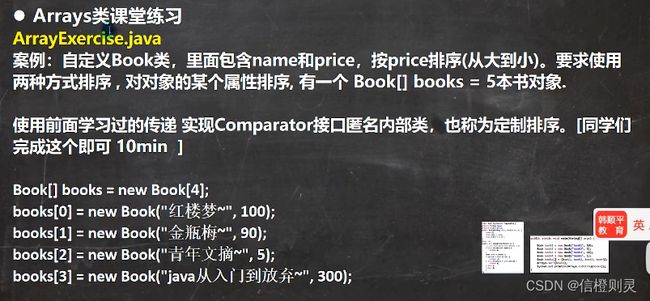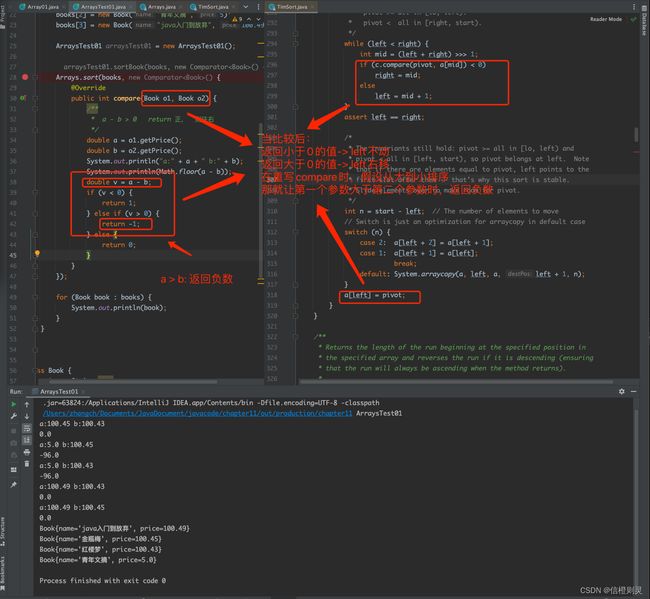Java Arrays类
Arrays类
介绍
用于管理或操作数组(比如排序和搜索)
常用方法
1、Arrays.toString(ints):返回数组的字符串形式
int[] ints = {1, 2, 3, 4, 5};
System.out.println(Arrays.toString(ints));
2、sort排序(自然排序和定制排序)
import java.util.Arrays;
import java.util.Comparator;
public class Array01 {
public static void main(String[] args) {
int[] ints = {1, 2, 3, 4, 5};
System.out.println(Arrays.toString(ints));
Integer[] arr = {-1, -2, 12};
Arrays.sort(arr);
System.out.println(Arrays.toString(arr));
Arrays.sort(arr, new Comparator() {
@Override
public int compare(Integer o1, Integer o2) {
return o2 - o1;
}
});
System.out.println(Arrays.toString(arr));
}
}
package com.hspedu.arrays_;
import java.util.Arrays;
import java.util.Comparator;
/**
* @author 韩顺平
* @version 1.0
*/
public class ArraysSortCustom {
public static void main(String[] args) {
int[] arr = {1, -1, 8, 0, 20};
//bubble01(arr);
bubble02(arr, new Comparator() {
@Override
public int compare(Object o1, Object o2) {
int i1 = (Integer) o1;
int i2 = (Integer) o2;
return i2 - i1;// return i2 - i1;
}
});
System.out.println("==定制排序后的情况==");
System.out.println(Arrays.toString(arr));
}
//使用冒泡完成排序
public static void bubble01(int[] arr) {
int temp = 0;
for (int i = 0; i < arr.length - 1; i++) {
for (int j = 0; j < arr.length - 1 - i; j++) {
//从小到大
if (arr[j] > arr[j + 1]) {
temp = arr[j];
arr[j] = arr[j + 1];
arr[j + 1] = temp;
}
}
}
}
//结合冒泡 + 定制
public static void bubble02(int[] arr, Comparator c) {
int temp = 0;
for (int i = 0; i < arr.length - 1; i++) {
for (int j = 0; j < arr.length - 1 - i; j++) {
//数组排序由 c.compare(arr[j], arr[j + 1])返回的值决定
if (c.compare(arr[j], arr[j + 1]) > 0) {
temp = arr[j];
arr[j] = arr[j + 1];
arr[j + 1] = temp;
}
}
}
}
}
0482_韩顺平Java_Arrays模拟排序_哔哩哔哩_bilibili
binarySearch通过二分搜索法进行查找
要求 arrays 必须排好序,如果数组为无序的,则不能使用binarySearch方法
在使用该方法时,如果查找的元素不在数组中,则返回-(low + 1); 看下面的代码
import java.util.Arrays;
public class Array01 {
public static void main(String[] args) {
int[] ints = {1, 2, 3, 4, 5};
int index = Arrays.binarySearch(ints, 122);
// 122如果存在于数组中的话,位置应该在 元素5 的后面
// return -(low + 1); --> low在源码中代表元素的位置,从1开始
// return -(5 + 1); --> -6
System.out.println(index);
}
}
copyOf
从arr数组中,拷贝固定长度(从头开始计数)的元素到 数组 中。新建一个数组对象
-
如果拷贝的长度大于数组的长度,则在新数组后面添加null
-
如果长度为负数,则抛出异常
int[] ints = {1, 2, 3, 4, 5};
int[] intsCopy = Arrays.copyOf(ints, ints.length-2);
System.out.println(Arrays.toString(intsCopy));
fill
数组填充:将数组中的每个元素都替换成一个元素
int[] ints = {1, 2, 3, 4, 5};
Arrays.fill(ints, 99);
// 输出为 [99, 99, 99, 99, 99]
System.out.println(Arrays.toString(ints));
equals
比较两个数组中的元素是否完全一致(大小和顺序均一致),如果数组元素完全一致,则返回true
int[] ints = {1, 2, 3, 4, 5};
int[] ints2 = {1, 2, 3, 5, 4};
// 输出为: false
System.out.println(Arrays.equals(ints, ints2));
asList
将一组值,转换为一个List集合
List asListTest = Arrays.asList("zhang", "cheng");
// 输出为 [zhang, cheng]
System.out.println(asListTest);
// asListTest的编译类型为 List
// asListTest的运行类型为: class java.util.Arrays$ArrayList
System.out.println(asListTest.getClass());
测试题
import java.util.Arrays;
import java.util.Comparator;
public class ArraysTest01 {
public void sortBook(Book[] books, Comparator comparator) {
for (int i = 0; i < books.length - 1; i++) {
for (int j = i + 1; j < books.length; j++) {
if (comparator.compare(books[i], books[j]) < 0) {
Book temp = books[i];
books[i] = books[j];
books[j] = temp;
}
}
}
}
public static void main(String[] args) {
Book[] books = new Book[4];
books[0] = new Book("红楼梦", 100.43);
books[1] = new Book("金瓶梅", 100.45);
books[2] = new Book("青年文摘", 5);
books[3] = new Book("java入门到放弃", 100.49);
ArraysTest01 arraysTest01 = new ArraysTest01();
arraysTest01.sortBook(books, new Comparator<Book>() {
// Arrays.sort(books, new Comparator() {
@Override
public int compare(Book o1, Book o2) {
double a = o1.getPrice();
double b = o2.getPrice();
System.out.println("a:" + a + " b:" + b);
System.out.println(Math.floor(a - b));
double v = a - b;
if (v < 0) {
return 1;
} else if (v > 0) {
return -1;
} else {
return 0;
}
}
});
for (Book book : books) {
System.out.println(book);
}
}
}
class Book {
private String name;
private double price;
public Book(String name, double price) {
this.name = name;
this.price = price;
}
public double getPrice() {
return price;
}
@Override
public String toString() {
return "Book{" + "name='" + name + '\'' + ", price=" + price + '}';
}
}

